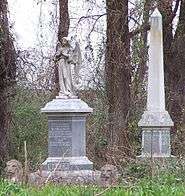Olivewood Cemetery
Olivewood Cemetery, in Houston, Texas, lies near a bend in White Oak Bayou, along the rail line to Chaney Junction, where the First and Sixth wards meet just northwest of downtown. The 6-acre (24,000 m2) cemetery is an historic resting place for many freed slaves and some of Houston’s earliest black residents.

History
In 1875, the land, which had previously been used for slave burials, was purchased by Richard Brock, Houston's first black alderman. It opened as a cemetery for black Methodists in 1877.[1] When Olivewood was platted, it was the first African-Americans burial ground within the Houston city limits.[2]
Many 19th century influential African-Americans were buried in the cemetery, including Reverend Elias Dibble, first minister of Trinity United Methodist Church; Reverend Wade H. Logan, also a minister of the church; and James Kyle, a blacksmith; as well as Richard Brock.[3]
The cemetery includes more than 700 family plots around a graceful, elliptical drive that originated at an ornate entry gate. It contains graves of both the well-to-do and those who died in poverty; therefore, the grave markers run the gamut from elaborate Victorian monuments to simple, handmade headstones. Burials at Olivewood Cemetery continued through the 1960s.[4]

In 2003, after decades of neglect and abandonment, the "Descendants of Olivewood," a nonprofit organization, was established to take guardianship of the cemetery, "to provide care and to protect its historical significance."[2]
Olivewood was designated an Historic Texas Cemetery. By 2010 water and vandals threatened to damage graves in a portion of the cemetery.[5]
By 2013, a digital database for the cemetery has been created (many memorials created through using the death certificates found at www.familysearch.org) consisting mostly of the years 1910-1940 and can be found at www.findagrave.com (link listed below). This database has about 3,800 memorials and can be searched by using first and or last names.
Hauntings
Over the years, there have been numerous reports of mysterious after-dark sightings and strange movements within the graveyard.[2]
Cathi Bunn, a paranormal investigator, began exploring Olivewood in 1999. One moonlit midnight, Bunn said she videotaped the ghost of Mary White, who was buried in 1888, hovering above her headstone.[6]
References
- Aulbach, L.F. "Ghosts of Houston's Past Haunt the Cemeteries on Buffalo Bayou". Buffalo Bayou - An Echo of Houston's Wilderness Beginnings (2001). Retrieved 2007-06-02.
- Perry, J. "Grave undertaking: efforts to preserve earliest black cemetery". Houston Heritage, City Savvy (Online Ed. 2005). Archived from the original on 2007-04-15. Retrieved 2007-06-02.
- "Black Cemetery Preservation/Tombstone Transcription". Projects, Afro-American Historical and Genealogical Society, Inc. (AAHGS - H-Town, 2003-2004). Retrieved 2007-06-02.
- "Preservation Update". Greater Houston Preservation Alliance. Archived from the original on 2006-12-08. Retrieved 2007-06-02.
- Gonzalez, J.R. "Help needed to rescue threatened graves near downtown." Houston Chronicle. May 17, 2010. Retrieved on May 17, 2010.
- "Historic and Haunted Olivewood Cemetery". Cemeteries, The Ghastly Ghost Hunter. Retrieved 2007-06-02.